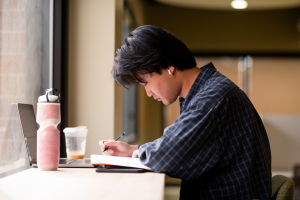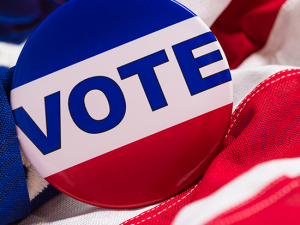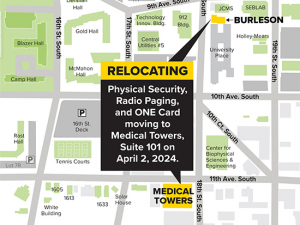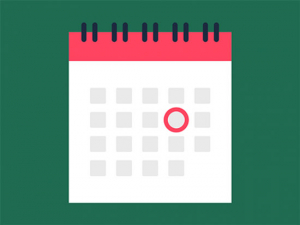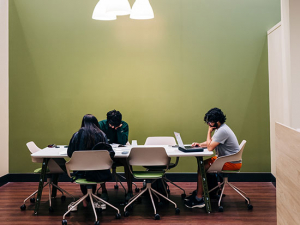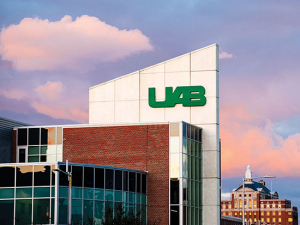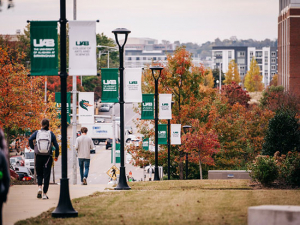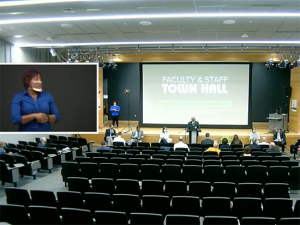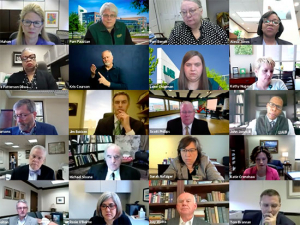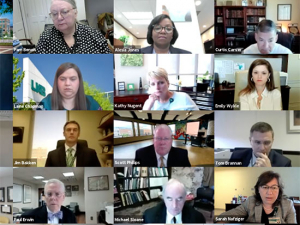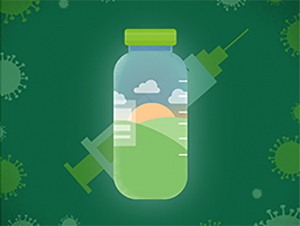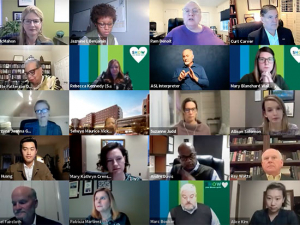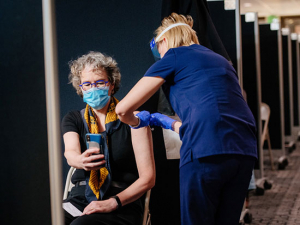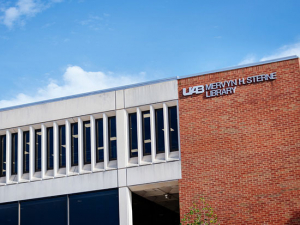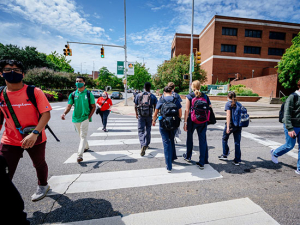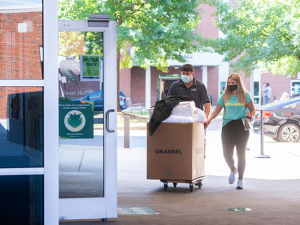Editor’s Note: The information published in this story is accurate at the time of publication. Always refer to uab.edu/uabunited for UAB’s current guidelines and recommendations relating to COVID-19.
President Ray Watts and other UAB leaders shared updates and data around the omicron variant surge, the decision to hold an in-person spring semester, campus events and more during a virtual town hall for students Jan. 12.
Students submitted dozens of questions and comments before and during the hourlong event. Many were answered in the town hall, which can be watched in full above. (To jump to comments from specific presenters in the video, click here.) Selected comments from the event are below, along with responses from senior leaders to all questions that could not be answered live due to time constraints and all questions answered in the chat during the event.
Scroll down to read the complete summary or use the links below to jump to specific topics
Decision for an in-person semester
Commencement, spring break and in-person events
Omicron medical and epidemiology update
Student Health testing and appointments
Reporting symptoms or exposure
Cleaning after infections reported
Isolation/quarantine for UAB Housing residents
Decision for an in-person semester
“Once again, we are in the midst of a COVID surge, this one omicron,” Watts said. “The good thing about omicron is it is primarily an upper respiratory infection and not a lower respiratory infection, but it is highly contagious .... We know the tools to keep us safe, and that’s primary in all of our minds, and that is masking and vaccination and making sure that you don’t get exposed to someone else who does not have a mask and is infected or might be.
“You’ll hear from our team of leaders and experts why we have returned to campus,” Watts continued. “Some people ask why. Most people want to be back to campus. We wouldn’t do it if it’s not safe. We know how to manage this now, and it is likely that coronavirus will be with us for potentially a long time.”
“One of the things that we know is that student success is impacted by being in in-person classes, and we also know that being out of the classroom has a negative effect on student mental health,” said Provost Pam Benoit. “We don’t want students to feel isolated or depressed if we can do anything to help address those kinds of issues. That’s part of the decision-making process that went into having in-person classes. We also know that we can adjust. We’ve already proven that we have been able to adjust when necessary .... We have gone through it before, and we have even more tools in our toolbox now with the vaccines and the high level of vaccinations on campus. That can help us to continue to have in-person kinds of classes.”
Use the links below to jump to comments from specific town hall speakers:
- Angela Lee, president, Undergraduate Student Government Association
- Jasmine Benjamin, president, Graduate Student Government
- President Ray Watts
- Provost Pam Benoit
- Lisa Schwiebert, Ph.D., interim dean, Graduate School
- Suzanne Judd, Ph.D., epidemiologist and professor in the School of Public Health
- Michael Faircloth, M.D., director, Student Health Services
- Marc Booker, executive director, Student Housing and Dining
- Angela Stowe, Ph.D., director, Student Counseling Services
- John Jones, , Ph.D., vice president, Student Affairs
Why did UAB choose not to go remote/virtual for a few weeks?
QUESTION ANSWERED IN CHAT: Sitting in a classroom while masked is considered to be a low-transmission activity. In addition to our UAB data, there is great data from both the airlines and the theater industry demonstrating that the risk of contracting COVID in a seated, masked setting is extremely low. [See comments from epidemiologist Suzanne Judd below]
[back to topic list]
Commencement, spring break and in-person events
Several students asked about having an in-person commencement this semester, Benoit said. “We are all looking forward to that,” she said. “We are very optimistic that we’re going to be past the surge” in time for a traditional spring break and in-person commencement ceremony, “although you know we cannot predict what is coming next, so I can’t promise,” she said. “But I am very hopeful that both of those will go forward as usual.”
Is there a specific date we can look to by which the final determination will be made about in-person commencement?
“We continue to consult with our experts, and even though I would like to know today or next week, they provide the best advice about when we feel like we could make that decision,” Benoit said. “I can’t put an exact date on that. I would say continue to watch the commencement website. I will send out a note to those students who are scheduled to graduate and have registered to graduate letting them know when that decision gets made.”
“Due to the recent omicron variant and the surge of positive cases, we not only continued our current effective protocols but we also suspended in-person student events,” said John Jones, Ph.D., vice president for Student Affairs. “The suspension is based on the guidance from our public health, infectious disease and health care experts .... We will alter our approach when they deem it is appropriate and safe.”
“I want to reiterate that this is for the month of January and that we will reassess to see whether or not that needs to be extended,” Dr. Benoit added. “So this is not for the entire term.”
There is a difference between academic and non-academic student events, Benoit said. While non-academic student events are suspended in January, academic events are not: “So for example, service learning or a play that’s part of a class or a music performance that’s part of a class — those events will continue to be done. But we’ll be asking people to make sure that they follow safety protocols while they are doing them.”
[back to topic list]
Omicron medical and epidemiology update
Omicron infection unknowns
“What we’re seeing is just an unbelievable number of cases” during the current omicron surge, said Jeanne Marrazzo, M.D., director of UAB’s Division of Infectious Diseases.
“The problem is several-fold. One is that, even if you get it and it’s ‘mild,’ it still can be a miserable infection,” Marrazzo said. “You can lose your sense of smell, your sense of taste, and we don’t really know [about the prevalence in omicron of] something called long COVID, which I’m sure many of you have heard about, which is when you get over the initial infection, but you have persistent fatigue, brain fog, sometimes palpitations. A whole bunch of things .... We don’t know whether that’s going to turn out to be common at all with omicron.”
[back to topic list]
Avoiding omicron
“So our advice, of course, is don’t get it if you can help it,” Marrazzo said. “How do you not get it? You avoid it.”
Avoiding omicron boils down to three things, Marrazzo said:
1. Vaccination and boosters. “You really do want to be fully vaccinated,” Marrazzo said. “The CDC still defines fully vaccinated as having a primary series, and a primary series is defined as two shots of either mRNA vaccine, Pfizer or Moderna, or a single J&J vaccine. If you’ve had those, you are considered fully vaccinated.
“Most people on top of those have now gone ahead and gotten a booster, if you really want to optimize your protection. And why is that? Because we’re getting a very good sense that the protection afforded by these vaccines probably on average lasts about four to five to six months at the outside. That’s why we started seeing so many people get breakthrough infections even before omicron came on board. We still had delta infections in the fall, and we had several people who had gotten vaccinated, finished their series in the spring, and then were about six months out, October, and started to get breakthrough infections.
“Those are almost always ‘mild,’ and again I don’t want to oversell the mildness because I don’t want to get them,” Marrazzo said. “I don’t want anybody to get them if they can avoid it. So, getting vaccinated is really your first line of defense.”
2. Isolation. “There have been quite a lot of discussions about what that should look like and how long should it be,” Marrazzo said. “In general, where we’ve settled is that, after you get a positive test and if you’re asymptomatic, you count Day 0 as that positive test, or if you develop symptoms, you count Day 0 as the day you develop symptoms. You really want to have a minimum of five days [of isolation] where you are not at risk of infecting other people. You don’t necessarily need a test at the end of five days.”
In general, “if you feel really well for at least 24 hours, no fever, no cough, nothing that would suggest you are not infectious at five days, you are good to go,” Marrazzo said. “That’s a really important prong of our prevention and management control approach.”
3. Masks. “There is a lot of controversy and discussion about masks,” Marrazzo said. “On the one end, you have people who are saying we should ship N95s out to everybody in the world or in the country. N95s, remember, are the masks that we wear when we don’t want to be exposed to people who have tuberculosis, really infectious diseases. They are the gold standard for preventing the acquisition of airborne or droplet-transmitted viruses.
“Does everybody really need an N95? Again, it’s that kind of balance,” Marrazzo said. “Yeah, if we all had N95s and we all wore them all the time, we probably would shut down transmission of this virus momentarily. That is completely unrealistic for many reasons. So our advice, and I suspect what the CDC is going to say when they do clarify this, is that any mask is better than no mask. Any mask that you wear needs to cover your nose and your mouth.”
[back to topic list]
Proper masking
“If you have the best N95 in the world and it’s hanging off your chin, that is not going to protect you and it’s not going to protect me,” Marrazzo said. “We have some fantastic, really good cloth masks that fit like a glove and are very dense.
“The three parameters I think about for masks are [first] the density of the material,” Marrazzo said. “That’s why N95s are called that, because they prevent 95 percent of particulate matter getting into your nostrils.
“The fit is very important,” Marrazzo continued. “You don’t want to have leaky sides, which is why surgical masks are not necessarily always protecting us from omicron.
“And then the comfort. You want to be able to wear this in places where you are going to have substantial exposure. Is going into a coffee shop for two minutes to pick up your coffee a substantial exposure, and should you worry about COVID? I would worry about omicron everywhere, but remember the CDC defines close contact as 15 minutes in a 24-hour period within 6 feet of an infected person, and they have not changed that for omicron. It could be three five-minute periods [over that 24 hours], but 15 minutes [total] is what we’re talking about.”
You sent out an official email saying that we don’t need KN95s. The email said cloth masks were fine. It’s laughable to think that people have filters for cloth masks or that they wash their masks.
QUESTION ANSWERED IN CHAT: UAB masks have three layers. They were provided to all students in the fall. New students can get masks at the bookstore or from their dean’s office.
Were those masks also provided to grad students? I never received a mask even though I started in the fall.
QUESTION ANSWERED IN CHAT: Yes. Check with your dean’s office if you need a mask.
[back to topic list]
COVID treatments
“The other reason I really don’t want you to get omicron is ... if you are unvaccinated and you get omicron and you get sick, we have nothing to treat you with if you are not sick enough to get in the hospital,” Marrazzo said. “So let me say that again: We have nothing to treat omicron with except IV remdesivir, which is a drug we’ve been using since the very beginning of the pandemic. There are two pills now that are approved. We don’t have access to them yet. There is now only one monoclonal antibody that works, and I can tell you we’re going to get six doses of that this week to last us two weeks .... The best way to not be in a situation where you are faced with a serious illness or your loved ones are faced with a serious illness is to just not get infected. So vaccination, masks, isolation to the extent you can.”
[back to topic list]
How omicron spreads
Omicron transmission depends on the same two basic factors as all COVID transmission: contact and type of activity, said epidemiologist Suzanne Judd, Ph.D., professor in the UAB School of Public Health and a key adviser on UAB’s COVID-19 Incident Command Committee. “You have to come in contact with an infected individual, and given that the individual is infected, the type of activity that you do when you’re in contact with that individual matters,” Judd said. “For example, if you are sitting in a classroom listening to a professor and you are masked, that’s what we call an extremely low-transmission activity.”
There are three key data sources pointing to attending classes as an extremely low-transmission activity, Judd said.
UAB data: “We have data from UAB we’ve been monitoring since fall 2020 on how likely people are to become infected with COVID if they’re sitting next to someone in a classroom,” Judd said, “and basically the odds are very low, down to zero. We haven’t had any examples of transmission in the classroom at UAB.”
Airline data: “Our data is backed up by data from the airlines,” Judd said. “The airlines probably do the best contact tracing in the nation. They’ve had a lot of federal money to do that since the beginning, and they are able to look and see who is sitting around a passenger when they find out that somebody is COVID-positive, and they can do the contact tracing to see who becomes COVID-positive afterward. Again, very little transmission on airplanes, including when you are sitting at the gate, and most people say, well, that’s because airlines turn their air over so much. They only do that when they are flying. When you are sitting at the gate, when you are boarding, when you are moving back and forth on the plane, you are not getting that same air turnover, and yet we still see very little transmission in that setting.”
NYC event data: “The third place, and this is most recent, and it actually is with omicron data ... has been in auditoriums in New York City and other places across the U.S. [that] began bringing out musicals and theater, ballets again back in the fall .... New York did that right in the middle of their omicron surge, and they collected a lot of data on their Broadway reopening. They didn’t have any examples of transmission in the audience. And the audience was fully masked — they also had to be vaccinated to attend — but no transmission in the audience, even though the performers often did have some examples of transmission that the contact tracers were able to find. But the performers weren’t wearing masks.
“So again, we’ve got three great sources that show that, if your activity is a light activity where you are passively sitting next to someone wearing a mask, it is a very low-transmission setting,” Judd said.
[back to topic list]
Herd immunity and omicron
“Herd immunity might not be possible with this virus,” Judd said. “It looks like, with SARS-CoV-2, this particularly coronavirus may be like other coronaviruses where we get this kind of cyclic immunity. You get sick from the infection, you develop immunity, and then that immunity may wane over time. This is very normal for other coronaviruses.
“As a community of infectious disease and epidemiologists, we were really hoping that this particular virus would develop lasting immunity in the body,” Judd said. “But it may be that it’s a little bit cyclic. That just means that we have to manage it slightly differently. It means the virus is likely to be ‘endemic’ is the word that we use. You may have seen that word. It’s a fancy epidemiology word that just means it’s going to be with us forever, where it will have peaks and valleys that kind of ebb and flow, then we have to manage accordingly as we have those surges.”
[back to topic list]
Omicron case data for Alabama
“I tend to look at local trends rather than national trends,” Judd said. “We know that our hospitalization rate is roughly one-third of what it was during the delta wave, and the delta wave was lower than the wave before that. So, we’re seeing fewer people winding up in the hospital given the high rate of cases.
“Let’s talk a little bit about cases, because that’s what you’re reading about and that’s probably what’s scaring you today,” Judd continued. “We’re having explosive case growth in Jefferson County. It’s what we were thinking would happen when omicron came. Many of the people who are testing positive don’t have any symptoms at all, and that’s another tricky thing with management because it makes it tough to know if you don’t have symptoms whether or not it’s safe for you to be around other people. That’s why we recommend widespread masking, no matter if you have symptoms or not.
“What’s going to happen in the future? It looks like the peak of this surge is going to hit in the next seven to 14 days,” Judd said. “It’s probably going to hit in Jefferson County sooner than it hits the rest of Alabama. We actually experienced the surge here in Jefferson County about five days ahead of the rest of the state. In fact, there are already some early indicators that we are nearing the peak.”
[back to topic list]
Student Health
Student Health testing and appointments
Appointments: “Specific to COVID, telehealth appointments are available for the initial evaluation of COVID concerns or other issues,” said Michael Faircloth, M.D., medical director for Student Health.
“Particularly if you are symptomatic, you can get your initial evaluation through telehealth, and these are also web-bookable,” Faircloth said. “We will certainly see you in person if you prefer, even on the initial visit, or if we determine you need further evaluation or testing, we’ll certainly ask you to come in to be seen in person. If you are coming in as a walk-in, you will at least at minimum be triaged by an R.N.; but if you are going to walk in, we ask that you please call ahead if you have any fever, cough or other respiratory symptoms to let us know that you are coming.”
Testing: “We offer appointment-based, free in-house point-of-care rapid COVID testing, both antigen and PCR-based platforms,” Faircloth said. “Most of this rapid testing is reserved for symptomatic students, but we’re also offering asymptomatic testing in collaboration with Quest Labs. These are PCR-based tests that usually result within 24 to 48 hours as these have to be sent to Quest Labs for processing. Rapid antigen testing of asymptomatic students is available as circumstances dictate need for a rapid test.”
[back to topic list]
Reporting symptoms or exposure
“For COVID reporting, we ask all students with symptoms or a potential COVID exposure to immediately complete the Student Health Services COVID Survey, which is available through your patient portal,” Faircloth said. “You will receive instructions immediately upon completion of this initial survey that defines your next actions, and then Student Health will continue to follow you daily throughout the period of your isolation or quarantine.
[back to topic list]
Isolation and quarantine
“Please isolate or quarantine immediately upon developing symptoms or a potential exposure until you receive further evaluation and are cleared by Student Health,” Faircloth said. “Student Health is aligning with the most current CDC guidance for the timelines for isolation and quarantine ... and that is a five-day minimum for both. You will receive individualized guidance around clearance from your Student Health Services COVID team, usually from an R.N. or a clinical provider .... On Day Five, you will be reevaluated for potential clearance. For potential exposures, we will assist you in determining if this was a true exposure and if you really need quarantine or not. There is a limited role for antigen testing at Day Five for isolated students, but this is again individualized to need.”
[back to topic list]
Cleaning after infections reported
“I also report all spaces that we’re aware of where students have been positive and have been on campus, such as a classroom or lab, to Facilities every evening, and then these spaces undergo enhanced cleaning that same evening,” Faircloth said.
[back to topic list]
Isolation/quarantine for housing residents
“We encourage our housing residents on campus to quarantine and isolate off campus if it’s practical to do so,” said Marc Booker, executive director of Student Housing and Dining. “If [that is not practical], we do have space on campus for you to isolate. All of our guidelines are posted on our website at uab.edu/housing, and click on the Current Students tab.”
[back to topic list]
Vaccinations
I received a J&J vaccine with a Pfizer booster. Am I considered fully vaccinated?
Yes. In fact, everyone is still considered fully vaccinated two weeks after the single-dose J&J vaccine regardless of booster status.
The CDC says vaccinated people do not necessarily need to test and isolate for a known COVID exposure. What is UAB’s expectation for staff that have been knowingly exposed?
All employees (faculty and staff) are expected to report symptoms or exposure to Employee Health immediately by an online form. Employee Health doctors and nurses review this information and make decisions on appropriate testing and isolation measures, which are communicated to the employee.
[back to topic list]
Academic questions
Remote learning
As the surge worsens, at what point would UAB decide to switch to remote learning?
“That’s always a really tricky question,” Judd said. “I can tell you that the metrics we look at [include] hospitalizations and the rate of hospitalization — the number of people that wind up in the hospital per case .... Managing the epidemic requires looking at multiple types of data. It could change on a dime. The virus could mutate again. It could become where more folks are winding up in the hospital. So basically, every week we look at those metrics and we make sure that they are going in the direction anticipated and not moving off course.”
Would UAB move in-person labs where students and instructors have to be in close contact to an online setting before they would move lecture classes? And what would the threshold of community transmission look like?
“We faced this question earlier [in 2020 and 2021] with labs and classrooms as well,” Benoit said. “What we found was that, in a lot of the lab settings, there were already ways that they could mitigate by scheduling different times people were in the labs and by making sure that there are masks [being worn]. Most of those individuals in the labs are already wearing masks, so that was good as well.
“Again, we look at the data to determine what kind of recommendations should be made,” Benoit said. “If we found for example high transmissibility rates in the labs that were much higher for some reason than in classrooms, then we might make a different kind of decision regarding labs. So far, there hasn’t been any evidence that suggests that would be the case. We go back to what Dr. Judd said: If you are doing low-level activities and not singing, not shouting — and that’s typically not what’s being done in a research lab — those are very low-transmission kinds of settings. So, I don’t anticipate that we would have a different decision for different contexts.”
How can the university accommodate students in isolation to prevent course content being missed? Zoom should be an option for all courses, so that students can be hybrid, if necessary.
Students in isolation and quarantine should take the following steps to complete coursework:
- First, contact Student Health Services to ensure that your instructors receive “should not be in class on campus” status notifications for you.
- Second, contact your instructors directly to learn what resources are available for students excused from in-person activities. A resource offered to students may include video recordings of class lectures.
Why am I not being provided course materials by professors despite being told to stay home and quarantine/isolate by student health?
QUESTION ANSWERED IN CHAT: First, be sure you have reached out to the professor. If you continue to have issues, contact the chair of the department for the course.
Has the CDC produced studies showing the efficacy of five-day isolation?
QUESTION ANSWERED IN CHAT: The five-day isolation recommendation comes mostly from observational data — not randomized trials, which are the gold standard for interventions but are too cumbersome and not quick enough to provide the answers we need now. The recommendation comes from following the levels of virus (delta variant, primarily, though we expect omicron data very soon) day by day from the initial infection on. By five days, MOST people have a low enough virus level especially in the nose to reassure us that they’re unlikely to be sources of infection, ESPECIALLY if they have no symptoms.
I’m curious about the outcomes of hybrid classes during the pandemic. It seems that the university prefers face-to-face. As a commuter graduate student and new mom, the hybrid classes enabled me to have more flexibility in life and pursue more than I thought. I know there must be a reason that they aren’t as prevalent this semester, and I am just curious as to why?
“Hybrid” in the example provided is considered “remote learning” at UAB, which was offered during the pandemic. UAB offers a wide variety of courses (“Q” section) and programs. We encourage you to investigate these offerings at UAB Online.
I can understand why the university may want to provide an in-person class format for the students who benefit more from that style of learning, but with concerns of infection and anxiety surrounding the pandemic, what is your reasoning for not allowing students to optionally attend class remotely, especially when most classes already have that option available for those actively sick with COVID?
The formats for teaching during the spring 2022 semester are either fully in-person courses or fully online courses such as asynchronous “Q” courses, in addition to some online courses with periodic in-person requirements that are traditionally available in some schools. As Dr. Judd indicated during the town hall, masked classrooms are considered a low-transmission setting because people wear masks and speak in normal voices, rather than yelling or singing. UAB has effective isolation and quarantine protocols in place to exclude students who are symptomatic, COVID-positive or exposed, and as appropriate, from the classroom and other campus activities until cleared to return by Student Health Services. In addition to these protocols, the amazing compliance of students and faculty with safety measures has resulted in a very safe classroom environment for COVID transmission. Dr. Judd also explained that the transmission of the virus is higher in high-risk situations, such as in the community around large gatherings. Students can reduce their risk and better ensure their ability to attend in-person classes by being mindful of their activities outside of campus.
Will professors offer an alternate online learning experience for classes that are only taught in person for students that have immunocompromised family members?
QUESTION ANSWERED IN CHAT: Some professors have already built in technological ways to learn material (recorded lectures, Zoom, etc.). You should check with your particular professors about what is available. You can significantly reduce risk by getting vaccinated and wearing a mask. As Dr. Judd indicated, there is extremely low transmission in the classroom. Think about your other activities to also reduce risk.
[back to topic list]
Building ventilation
What efforts have been made to assess the quality and quantity of ventilation in UAB classrooms? For several common areas in my college’s building, I am interested in the number of air changes per hour and the percentage of outdoor air provided by the HVAC system, as well as the MERV-level filtration of any recirculated air. Does UAB track this information (i.e., through a building automation system), and if so, can it be shared with students that are concerned about our indoor air quality?
Our Facilities team continues to operate our buildings with the maximum level of fresh outside air being brought in. We have also installed the highest-quality filtration available for the units on campus. If you have a question about a specific building or area, reach out to Chief Facilities Officer Greg Parsons or the Facilities staff. We are closely monitoring the most recent data and adapting our operations, based on the current guidance available (CDC; American Society of Heating, Refrigerating and Air-Conditioning Engineers; etc.). If new information regarding these systems is provided through the CDC, we will address it quickly.
[back to topic list]
Other questions
Is the school still providing CARES Act money to help with tuition, books, etc.?
“Yes, and now that spring aid is disbursed, we will begin reviewing student financial data for eligibility,” said Bradley Barnes, Ph.D., vice provost for Enrollment Management. “Award criteria that we will be looking for as we prioritize the remaining higher ed emergency relief funds include students with past due balances that have previously qualified for HEERF assistance. So students, if you think that you fall into this category, please contact the Office of Financial Aid and we will be happy to discuss this with you.”
What if an online student wants to visit campus by visit visa and wants to meet faculty and staff? How will the student be entertained in such a scenario (e.g., who will meet and greet, any facility for short-term accommodation, etc.)?
There are a variety of ways that students can experience UAB, and they can learn more about doing so here.
[back to topic list]
